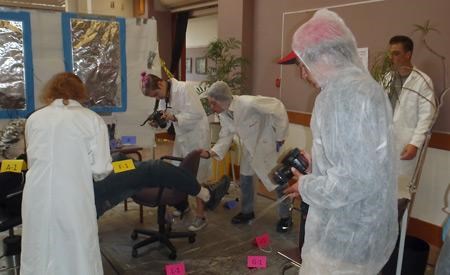It’s a whodunnit with an educational twist.
Instead of simply diving into a Raymond Chandler novel in English class, a group of grade 11 students at Brooks Secondary School is learning hands-on what it takes to catch a killer. And while the crime may not be real, the science used to narrow down the list of suspects certainly is.
Colleen Balzer, a chemistry teacher at the high school, has been teaching the Science and Technology 11 class for the past seven years at Brooks. One of the course’s four units is on forensic science.
With the popularity of crime scene investigation television programs, the course is helping students sort out the science from the science fiction.
Balzer’s class has spent the last six weeks learning a variety of different lab techniques including blood splatter analysis, finger- and shoe-print lifting and comparison to name a few.
“This is their culminating assignment,” Balzer said in a telephone interview with the Peak.
A mock crime scene was set up at the school with the help of Balzer’s former students. No one knows the true identity of the killer except for the person who wrote the story and designed the scene.
This year the crime is murder most foul in a barbershop. The class comes in and investigates the scene, collects evidence and takes photos to document it, Balzer said.
Students are dusting for prints, documenting evidence as they see it and putting the crime scene evidence markers down to mark where clues are discovered, she said.
Once the crime scene is processed, the students put on their lab tech hats and start analyzing the evidence for patterns and connections. They write reports based on what they find. Of the list of 20 suspects, half are teachers and the other half students. All have had their fingerprints taken.
Then the science class students become detectives and try to narrow the suspect pool until the evidence points to a particular person, she said.
“Hopefully by the end they have narrowed it down to one or two,” said Balzer. The students present their theories to scene creator Lee Dimond and if they are correct, they are then authorized to make an arrest, she added.
“The student’s do really well and they love it,” said Balzer. “They get in there and really become the characters. It’s a lot of fun.”



